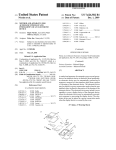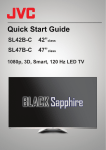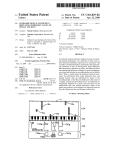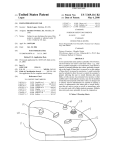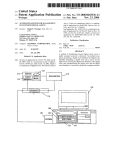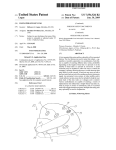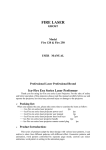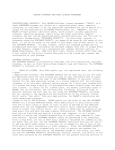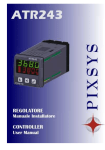Download Method of automatic monitor display adjustments
Transcript
US007068293B2 (12) United States Patent (10) Patent N0.: Wang (54) US 7,068,293 B2 (45) Date of Patent: METHOD OF AUTOMATIC MONITOR (58) Jun. 27, 2006 Field of Classi?cation Search ............... .. 345/3.4, DISPLAY ADJUSTMENTS 345/204, 211, 214, 6984699, 874104; 348/184, 348/558 (75) IIIVeIlIOrI Jui-Ming Wang, Taipei (TW) See application ?le for complete search history. (73) Assignee: AmTRAN Technology, Taipei (TW) (*) Notice: (56) Subject to any disclaimer, the term of this U'S' PATENT DOCUMENTS patent is extended or adjusted under 35 U.S.C. 15406) by 353 days. (21) References Cited 6,121,962 A * 6,366,263 B1* Appl. No.: 10/632,812 * (22) Filed: Aug. 4,2003 9/2000 Hwang ..................... .. 345/211 4/2002 Takasu et a1. .............. .. 345/13 6,392,642 Bl* 5/2002 6,597,373 B1 * 7/2003 Singla et a1 6,674,491 Bl* 1/2004 . Wu ................ .. 345/213 .. 345/698 Tsou ........................ .. 348/819 . “ted by exammer Primary ExamineriRicardo Osorio Assistant ExamineriMansour M. Said (65) Prior Publication Data Us 2004/0183823 A1 (30) Sep. 23, 2004 P-L-C (57) ABSTRACT A method of automatic monitor display adjustments is Foreign Application Priority Data Mar. 21, 2003 (51) Int, C], G09G 5/02 (52) (74) Attorney, Agent, or FirmiHamess, Dickey & Pierce, (TW) ............................ .. 92106308 A disclosed After the monitor is Connected to the Power and receives a display signal from a computer host, NTAA (No Touch Auto Adjustment) is initiated to automatically adjust the display range and other display settings of the monitor. (2006.01) US. Cl. ..................... .. 345/698; 345/204; 345/699 11 Claims, 4 Drawing Sheets START ) 310 V Simultaneou sly receiving the signals of the MENU, AUTO, and POWER keys 320 Y i Reading the default screen tuning parameters i 330 Y i Receiving the MENU signal i 340 i Providing a main menu i 350 i Receiving the RECALL signal i 360 Y Adjusting the monitor screen according to the default settings 370 V Changing the NTAA ?ag V @ U.S. Patent Jun. 27, 2006 ( Sheet 1 of4 START US 7,068,293 B2 ) 110 V Receiving a screen display signal 120 V Determining the screen display signal is incompatible with the monitor display range 130 V Performing the automatic monitor display adjustments 140 V Automatically adjusting the monitor display range V @ FlG.l U.S. Patent Jun. 27, 2006 Sheet 2 of4 US 7,068,293 B2 Whether the NTAA ?ag is 1 Whether to start a user operation interface Executing automatic adjustments NO 241 Whether the adjustments are complete 242 V V The NTAA flag The NTAA ?ag is set as 1 15 Set as 0 END FIG.2-A CD U.S. Patent Jun. 27, 2006 Sheet 3 of4 US 7,068,293 B2 250 Displaying the user operation interface 260 270 Pressing the AUTO key to Performing execute automatic adjustments manual adjustments Whether Whether the adjustments the manual adjustments are complete are ?nished _ FIG.2-B # NO U.S. Patent Jun. 27, 2006 ( Sheet 4 of4 START US 7,068,293 B2 l 310 T Simultaneously receiving the signals of the MENU, AUTO, and POWER keys 320 V Reading the default screen tuning parameters 330 V Receiving the MENU signal 340 V Providing a main menu 350 7 Receiving the RECALL signal 360 V Adjusting the monitor screen according to the default settings 370 V Changing the NTAA ?ag V @ FIGS US 7,068,293 B2 1 2 METHOD OF AUTOMATIC MONITOR DISPLAY ADJUSTMENTS FIGS. 2-A and 2-B are detailed ?oWcharts of the disclosed method; and FIG. 3 is a ?owchart of recalling the ?ag of the NTAA according to the invention. BACKGROUND OF THE INVENTION DETAILED DESCRIPTION OF THE INVENTION 1. Field of Invention The invention relates to a method of automatically adjust ing monitor display to tune the monitor display screen. 2. Related Art Currently, the monitors on the market, including the The speci?cation discloses a method of automatic monitor display adjustments. After the monitor is connected to a poWer source and receives a display signal from a computer traditional cathode ray tubes (CRT’s), the popular thin-?lm ?eld transistor (TFT) liquid crystal displays (LCD’s) or even the future plasma displays (PDP’s), usually use the default settings When the monitor ?rst receives display signals. host, the method automatically tunes the display range of the screen Without user’s manual adjustments. With reference to FIG. 1, the monitor ?rst receives a screen display signal (step 110). If the screen display signal Therefore, it is often seen that the frame is shifted to one side, larger or smaller than the screen. In order for the is determined to be incompatible With the monitor display range (step 120), the automatic monitor display adjustments display frame to ?t the screen, monitor manufacturers often provide some tuning buttons for the users to make adjust are performed (step 130). The monitor display range is also automatically adjusted (step 140), until the screen display ments at his or her Will. In spite of this, some users are afraid of using the 20 The method is an NTAA for monitors. Once the monitor is connected to a poWer source and the display card of a manufacturer provided tuning buttons simply because they do not knoW hoW to use them. Therefore, the tuning mecha nisms provided by the manufacturers are considered as not computer host, it can receive screen display signals trans human enough. To help these users, certain manufacturers start to design a neW tuning button, the so-called AUTO button. Using this button, the user can adjust the screen to 25 satisfactory settings Without much trouble. Even so, this pushing button action still requires human manipulation. Therefore, if the adjustment procedure can be performed or controlled by a program or device so that the signal ?t With the monitor display range. 30 mitted from the computer host and display the images. HoWever, in the beginning of screen displays, the NTAA ?rst determines Whether the display signal ?ts the monitor dis play range. If the display signal does not ?t the monitor display range, the NTAA executes the automatic screen adjustments to tune the screen display to the optimal vieW able range. It achieves the goal that the monitor screen has the best display range Without user’s manual adjustments. After the above explanation With reference to FIG. 1, We screen is automatically tuned to the best display range and conditions, the users Will be less afraid of using the moni further use FIGS. 2-A and 2-B to shoW an embodiment of the tors. invention, describing the automatic adjustment procedure in SUMMARY OF THE INVENTION 35 more detail. As shoWn in FIG. 2-A, after the monitor is connected to the poWer source and starts to receive screen display signals In vieW of the foregoing problems, the invention provides a method of automatic monitor display adjustments. After the monitor is connected to the poWer and receives a display signal from a computer host, NTAA (No Touch Auto Adjust ment) is initiated to automatically adjust the display range and other display settings of the monitor. 40 receives and displays the image signals from the computer. It is thus an objective of the invention to provide an automatic monitor adjustment method, through Which the user can obtain a desired screen display e?fect Without tuning 45 it on his or her oWn. To achieve the above objective, the disclosed method includes the steps of: receiving a screen display signal; determining Whether the screen display signal does not satisfy the monitor display range; executing automatic adjustments for the monitor display to automatically tune the display region to the best range. From the above brief description of the disclosed system and method, one sees that the problems existing in the prior from a computer, the NTAA ?rst determines Whether the ?ag of the NTAA is 1 (step 210). If the result is a “no,” then it means that the monitor display settings have been adjusted and the NTAA automatically shuts doWn. The monitor then If the result is a “yes,” then the NTAA further determines Whether to start a user operation interface (step 220). If the user does not touch any operation key in the monitor panel, the system starts to execute automatic adjustments (step 230). At this moment, the NTAA adjusts the display condi tions of the monitor according to the setting records stored in the memory. After the monitor display conditions are 50 55 can be solved. It is also expected that the monitor screen can be automatically tuned to satisfy the user Without manual adjustments. modi?ed, the NTAA also determines Whether the adjust ments are complete (step 240). If the determination result is a “no,” then the ?ag ofthe NTAA is set as 1 (step 241); the system returns to step 210 to repeat the previously men tioned procedure. If the determination result is a “yes,” then the ?ag of the NTAA is set as 0 (step 242). The NTAA automatically shuts doWn; and the monitor starts to receive and display screen displays signals transmitted from the computer. In FIG. 2-A, if the user touches any operation key on the BRIEF DESCRIPTION OF THE DRAWINGS 60 monitor panel during step 220 (determining Whether to start a user operation interface), the user operation interface is The invention Will become more fully understood from displayed (step 250), as shoWn in FIG. 2-B and the system the detailed description given hereinbeloW illustration only, Waits for the operation signal from the user. When the user presses the AUTO key to execute automatic adjustments and thus are not limitative of the present invention, and Wherein: FIG. 1 is the main ?owchart of the disclosed method of automatic monitor display adjustments; 65 (step 260), the NTAA adjusts the screen display conditions according to the setting records stored in the memory. After the monitor display conditions are modi?ed, the NTAA also US 7,068,293 B2 3 4 determines Whether the adjustments are complete (step 280). screen display signal is received after the monitor poWer is turned on, the method comprising: If the determination result is a “yes,” then the ?ag of the NTAA is set as 0 (step 242). The NTAA automatically shuts doWn; and the monitor starts to receive and display screen displays signals transmitted from the computer. If the deter receiving the screen display signal; determining that the screen display signal is not compat 5 mination result is a “no,” then the ?ag of the NTAA is set as 1 (step 242), as shoWn in FIG. 2-A; the system returns to step 210 to repeat the previously mentioned procedure. In FIG. 2-B, When the user uses the operational keys on the monitor panel of step 250 to perform manual adjust display range includes recalling a no-touch-auto-ad ments (step 270) to tune the monitor screen display, the justment (NTAA) ?ag Which includes: NTAA adjusts the display screen accordingly and records the user’s adjustment settings. After the user performs the tuning for a While, the NTAA determines Whether the manual adjustments are ?nished (step 290). If the determi nation result is a “no,” then the user keeps performing manual adjustments (step 270). If the determination result is a “yes,” then the ?ag of the NTAA is set as 0 (step 242), as shoWn in FIG. 2-A. The NTAA automatically shuts doWn and the monitor starts to receive and display the image simultaneously receiving a menu signal, an auto signal, and a poWer signal; reading a default monitor display settings; receiving the menu signal and providing a main menu; receiving a recall signal; adjusting the screen display according to the default monitor display settings; and 20 signals transmitted from the computer. In describing the above preferred embodiment, the pro cedure further contains the procedure of changing the moni recall, one has to simultaneously press the MENU, AUTO, and POWER keys. After the monitor simultaneously receives the signals of the MENU, AUTO, and POWER keys (step 310), the monitor starts to read the default screen changing the no-touch-auto-adjustment (NTAA) ?ag. 2. The method of claim 1 further providing a user opera tion interface for the user to adjust monitor display settings. 3. The method of claim 1, Wherein adjusting the screen tor display settings to the default ones. We use FIG. 3 to explain the procedure for recalling the ?ag of the NTAA. As shoWn in FIG. 3, before executing the monitor setting ible With the monitor display range; executing automatic monitor display adjustments; and automatically adjusting the monitor display range; Wherein the executing automatic monitor display adjust ments, and the automatically adjusting the monitor 25 display according to the default monitor display settings includes adjusting a contrast value. 4. The method of claim 1, Wherein adjusting the screen display according to the default monitor display settings 30 includes adjusting a brightness value. 5. The method of claim 1, Wherein adjusting the screen tuning parameters (step 320) to prepare for the display display according to the default monitor display settings setting recall. At this moment, the user has to press the MENU key for the monitor to receive the MENU signal (step 330). A main menu is then provided for the user to use (step 340). Through the guidance of the main menu, the user includes a color to preset adjustment. 6. The method of claim 1, Wherein adjusting the screen 35 display according to the default monitor display settings includes adjusting monitor signals. is led to execute the RECALL command. After the monitor 7. The method of claim 1, Wherein adjusting the screen receives the RECALL signal (step 350), the monitor screen display according to the default monitor display settings is adjusted according to the default settings (step 360). After ?nishing the RECALL settings, the NTAA ?ag is changed (step 370), completing the Whole RECALL procedure. includes language reset. 8. The method of claim 1, Wherein adjusting the screen 40 display according to the default monitor display settings The adjustments of the screen display settings include the folloWing items to be tuned: the CONTRAST value, the BRIGHTNESS value, the COLOR settings, the screen sig play) Position. nal settings (such as LCD ADJUST), the display language display according to the default monitor display settings setting, the H-OSD POSITION setting, the V-OSD POSI TION setting, the SMOOTHING setting, and the INVIS IBLE value. Through the default settings of the above items, the screen display can be automatically adjusted to the preset includes adjusting an H-OSD (Horizontal On Screen Dis 9. The method of claim 1, Wherein adjusting the screen 45 Position. 10. The method of claim 1, Wherein adjusting the screen display according to the default monitor display settings display mode. Certain variations Would be apparent to those skilled in the art, Which variations are considered Within the spirit and scope of the claimed invention. What is claimed is: 1. A method of automatic monitor display adjustments for automatically adjusting the monitor display When a ?rst includes adjusting a V-OSD (Vertical On Screen Display) 50 includes a smoothing adjustment. 11. The method of claim 1, Wherein adjusting the screen display according to the default monitor display settings includes an invisible adjustment.










